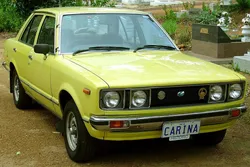

Toyota Carina Generation - A40 A50 Models
Explore the Toyota Carina generation, focusing on the A40 and A50 models. Discover details about these classic cars in Portugal's automotive landscape.
The Toyota Carina, a mid-sized car manufactured by the Japanese automaker Toyota, is well-regarded for its reliability and versatility. The second generation, known as A40 and A50, was produced from 1981 to...
Technical Specifications
Select Version
Dimensions
Engine
Driving
Others
History and Features
Mycarro AI
Apr 27, 2025
The Toyota Carina, a mid-sized car manufactured by the Japanese automaker Toyota, is well-regarded for its reliability and versatility. The second generation, known as A40 and A50, was produced from 1981 to 1988, marking a significant evolution in the Carina line-up. This generation aimed to blend performance, comfort, and efficiency while adapting to changing market demands.
Evolution of Design
The A40 Carina debuted in 1981 with a fresh design that featured a more aerodynamic body compared to its predecessor. It was available in both two-door coupe and four-door sedan variants, appealing to a broader range of consumers. By 1984, the A50 came into play with a modernized design that kept the foundational aesthetics of the A40 but added more curves and a refined nose, enhancing its visual appeal. The distinctive grille and headlight layout became hallmarks of the Carina’s design language that continued to evolve over the years.
Engine and Performance
Under the hood, the A40 and A50 Carinas offered a selection of engines that catered to different consumer preferences. Engine options included a 1.4-liter and a 1.6-liter four-cylinder engine, designed to provide a balance of power and fuel efficiency. The introduction of a 2.0-liter engine for the A50 made the vehicle capable of handling various driving conditions without significant sacrifices in fuel economy. Most variants were equipped with a five-speed manual transmission, while an automatic option was also available, making the Carina accessible to both driving enthusiasts and casual drivers.
Interior Comfort and Technology
The interior of the Carina A40 and A50 was designed with comfort and functionality in mind. The seating was spacious, offering ample legroom and headroom, making it a great choice for family trips or commuting. The dashboard layout was clear and ergonomic, featuring easy-to-read gauges and controls. As technology advanced in the mid-1980s, the Carina adapted by incorporating features such as optional electronic fuel injection, air conditioning, and improved audio systems, enhancing the driving experience further.
Safety Features
Toyota took significant strides in enhancing safety within the Carina's second-generation models. The introduction of crumple zones improved the car's ability to absorb impact, while seat belts became standard. In certain markets, additional safety features like anti-lock braking systems (ABS) began to appear in later models, reflecting the growing importance of safety in automobile design. The robust build quality ensured that the Carina was not just reliable but also offered a degree of protection for its occupants.
Market Presence and Legacy
The Carina A40 and A50 were particularly well-received in Europe and Asia, where they established a reputation as dependable family vehicles. The mid-sized sedan succeeded in attracting a range of consumers, from young professionals to families looking for a practical car. The durability and resale value of the Carina further solidified its status in the automotive market, with many owners enjoying their vehicles well into the following decades.
Conclusion
The Toyota Carina Generation 2 (A40, A50) laid the groundwork for subsequent generations, combining innovation with the core values that Toyota had championed. Known for its reliability, comfort, and efficiency, the Carina became a staple in the automotive landscape during the 1980s. As the automotive industry evolved, the Carina's legacy continued, showcasing Toyota’s commitment to meeting consumer needs while pushing the boundaries of car design and engineering. Although the Carina nameplate has been retired, its influence is still felt in the foundational principles of modern Toyota models.
